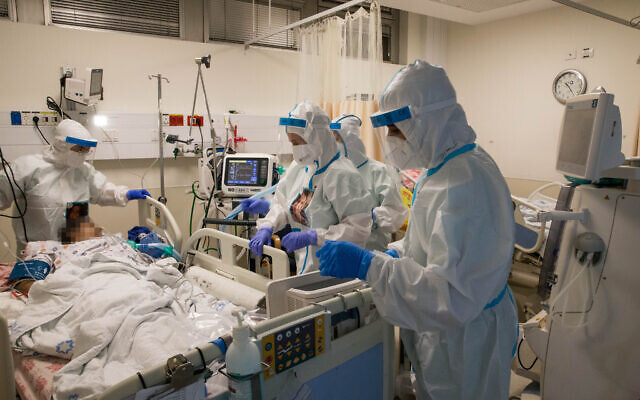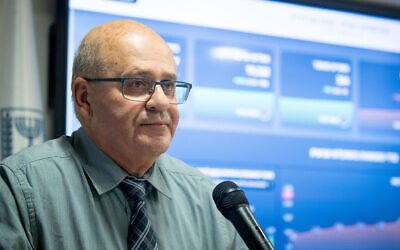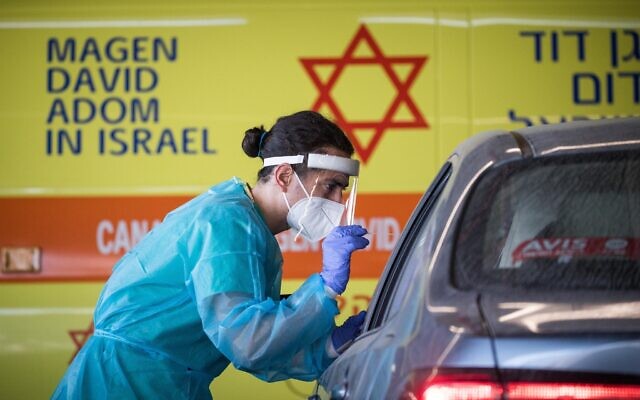The Health Ministry announced on Wednesday that the positive rate of coronavirus tests reached a record high of 15%, as a senior official reportedly told hospitals there would be 1,500 extra beds added nationwide by mid-October.
Test numbers have been lower this week due to Yom Kippur, slowly climbing to 34,352 on Tuesday, compared to some 50,000-60,000 daily tests over the past week. On Wednesday, 15 percent of tests came back positive, according to the Health Ministry.
There were 4,953 new coronavirus cases diagnosed on Tuesday, the relatively low number presumably a reflection of the fact that testing levels were very low on Monday.
The ministry said there were 810 serious COVID-19 patients, with 205 on ventilators.

Healthcare workers wearing protective clothes as they work at the coronavirus ward of Shaare Zedek hospital in Jerusalem on September 23, 2020. (Nati Shohat/Flash90)
Additionally, there were 293 patients in moderate condition and the ministry said the total number of hospitalized COVID-19 patients stood at 1,589.
Israel has had a total of 239,806 confirmed cases since the start of the pandemic, with 65,149 active cases.
A report in August by experts at the Weizmann Institute of Science predicted that hospitals would only be able to handle up to 800 serious patients. Israel crossed that threshold on Tuesday.
Prime Minister Benjamin Netanyahu on Monday said that the country should be prepared for 1,500 serious patients by Thursday but it was unclear why the sudden spike was expected.

Health Ministry Director-General Chezy Levy during a press conference in Jerusalem about the coronavirus on July 13, 2020. (Yonatan Sindel/Flash90)
Health Ministry Director-General Chezy Levy told hospital administrators on Wednesday that they would be implementing a plan to increase the national capacity by 1,500 hospital beds.
According to Channel 12 news, there will be 750 beds extra beds by October 5, with the remaining 750 in place by October 15. Of those beds, 20% will be for patients in critical condition who are on ventilators, while the remaining 80% will be for those in serious, moderate or mild condition.
The report did not specify if any particular medical centers would be targeted for an increase in beds.
Last month the Knesset heard that Israel managed to increase its hospital capacity by just 19 beds since the start of the coronavirus pandemic until July, and that beds were instead being utilized in other departments.
Hospitals have also warned that the increasing number of quarantined healthcare workers has created a serious manpower shortage. The Health Ministry on Wednesday said 3,769 healthcare workers are currently in isolation.
Levy told Army Radio that as hospitals became more congested, the level of care for COVID-19 patients would deteriorate due to their complicated medical requirements.
“In order to treat a complex patient like a patient in serious condition with coronavirus, years of [medical] experience are required. As their number increases, we fear that the quality of treatment will decrease,” Levy said.

A medical team member wearing protective gear takes a swab from a woman to test for COVID-19, outside the coronavirus unit at Shaare Zedek hospital in Jerusalem on September 24, 2020. (Yonatan Sindel/Flash90)
Science and Technology Minister Izhar Shay told the Kan public broadcaster that for two months after the mid-October end of the holidays, the country would come out of its full lockdown and switch to a localized system of closures dependent on contagion rates.
“We estimate that in the period between Simhat Torah and mid-December, we will move from the current [lockdown] to the traffic light system,” Shay said, without further clarifying the timeframe or explaining if it would be an immediate switch.

Izhar Shay poses at the Knesset, on April 29, 2019 (Noam Revkin Fenton/Flash90)
The plan distinguishes between areas with different infection levels, with “red” localities subject to the strictest restrictions and “green” ones having much looser rules.
In an effort to drive down the soaring daily new infection rates — which surpassed 8,000 on several days last week — a sweeping new lockdown took force on Friday.
Additionally, the Knesset passed a controversial measure to curtail public protests due to coronavirus regulations early Wednesday morning, following an all-night legislative session in which the opposition accused the government of harming democracy.
While the government had initially indicated the lockdown would last two to three weeks, officials and the prime minister have indicated in recent days it could last far longer.
 RSS Feed
RSS Feed















 September 30th, 2020
September 30th, 2020  Awake Goy
Awake Goy  Posted in
Posted in  Tags:
Tags: 













